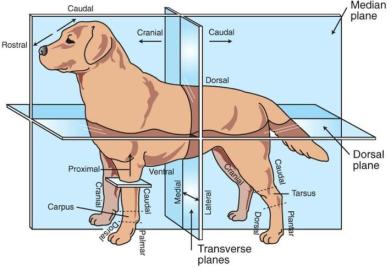
Lesson 3 Basic terminology
FLEXION: The movement of one bone in relation to another in such a manner that the angle formed at their joint is reduced. The limb is retracted or folded; the digit is bent; the back is arched dorsally.
EXTENSION: The movement of one bone upon another such that the angle formed at their joint increases. The limb reaches out or is extended; the digit is straightened; the back is straightened. Extension beyond 180 degrees is overextension.
ABDUCTION: The movement of a part away from the median plane.
ADDUCTION: The movement of a part toward the median plane.
CIRCUMDUCTION: The movement of a part when outlining the surface of a cone (e.g., the arm extended drawing a circle).
ROTATION: The movement of a part around its long axis (e.g., the action of the radius when using a
screwdriver). The direction of rotation of a limb or segment of a limb on its long axis is designated by the direction of movement of its cranial or dorsal surface (e.g., in medial rotation of the arm, the crest of the greater tubercle is turned medially).
SUPINATION: Lateral rotation of the appendage so that the palmar or plantar surface of the paw faces medially.
PRONATION: Medial rotation of the appendage from the supine position so that the palmar or plantar surface will face the substrate.


